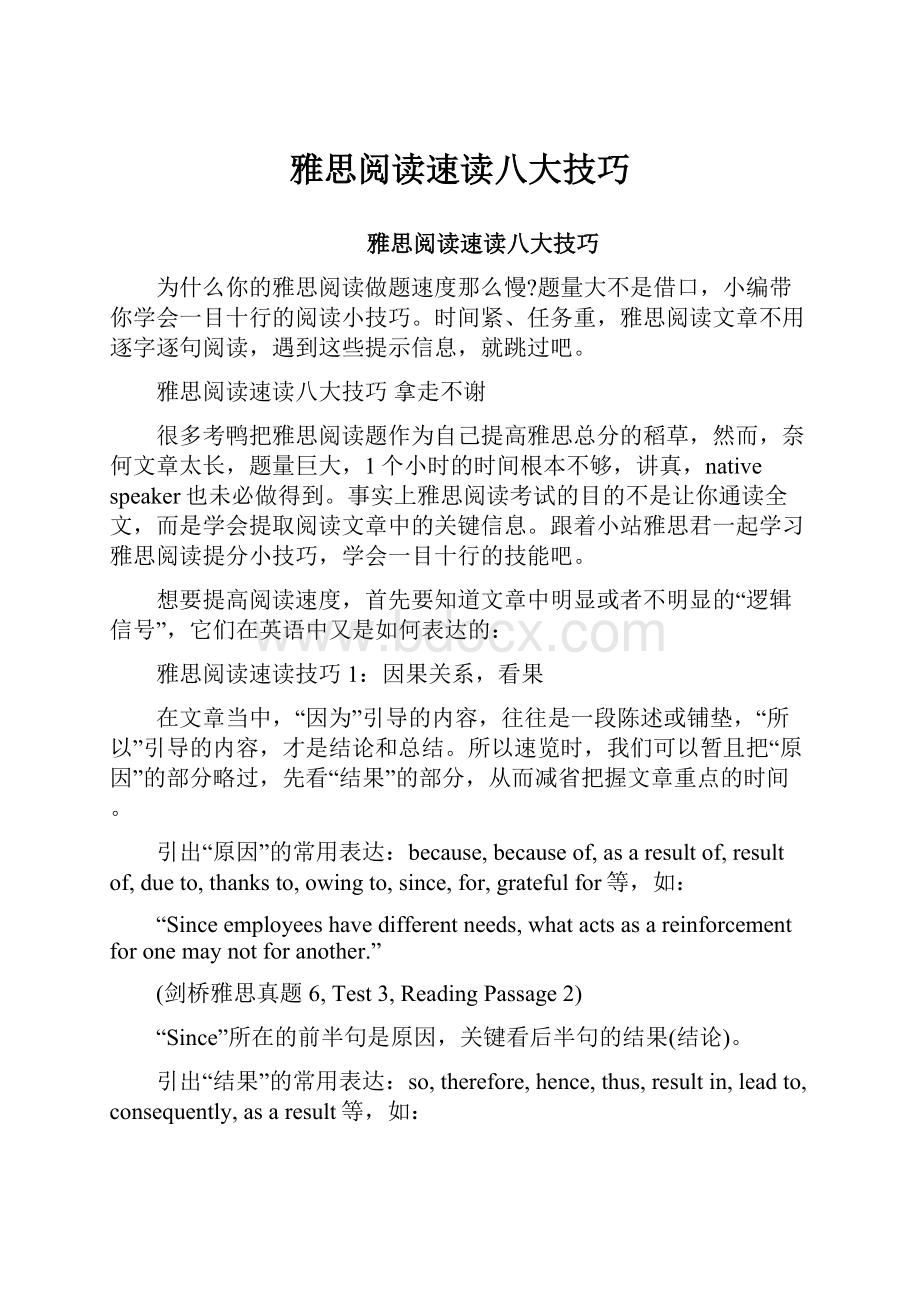雅思阅读速读八大技巧.docx
《雅思阅读速读八大技巧.docx》由会员分享,可在线阅读,更多相关《雅思阅读速读八大技巧.docx(13页珍藏版)》请在冰豆网上搜索。

雅思阅读速读八大技巧
雅思阅读速读八大技巧
为什么你的雅思阅读做题速度那么慢?
题量大不是借口,小编带你学会一目十行的阅读小技巧。
时间紧、任务重,雅思阅读文章不用逐字逐句阅读,遇到这些提示信息,就跳过吧。
雅思阅读速读八大技巧拿走不谢
很多考鸭把雅思阅读题作为自己提高雅思总分的稻草,然而,奈何文章太长,题量巨大,1个小时的时间根本不够,讲真,nativespeaker也未必做得到。
事实上雅思阅读考试的目的不是让你通读全文,而是学会提取阅读文章中的关键信息。
跟着小站雅思君一起学习雅思阅读提分小技巧,学会一目十行的技能吧。
想要提高阅读速度,首先要知道文章中明显或者不明显的“逻辑信号”,它们在英语中又是如何表达的:
雅思阅读速读技巧1:
因果关系,看果
在文章当中,“因为”引导的内容,往往是一段陈述或铺垫,“所以”引导的内容,才是结论和总结。
所以速览时,我们可以暂且把“原因”的部分略过,先看“结果”的部分,从而减省把握文章重点的时间。
引出“原因”的常用表达:
because,becauseof,asaresultof,resultof,dueto,thanksto,owingto,since,for,gratefulfor等,如:
“Sinceemployeeshavedifferentneeds,whatactsasareinforcementforonemaynotforanother.”
(剑桥雅思真题6,Test3,ReadingPassage2)
“Since”所在的前半句是原因,关键看后半句的结果(结论)。
引出“结果”的常用表达:
so,therefore,hence,thus,resultin,leadto,consequently,asaresult等,如:
“Suchfindingssuggestthatoneperson’sequityisanother’sinequity,soanidealshouldprobablyweighdifferentinputsandoutcomesaccordingtoemployeegroup.”
(剑桥雅思真题6,Test3,ReadingPassage2):
重点看“so”所在的后半句;
“Speechisoftenunclearandambiguous.Wherepossible,therefore,therecordinghastobesupplementedbytheobserver’swrittencommentsonthenon-verbalbehavioursoftheparticipants,andaboutthecontextingeneral.”
(剑桥雅思真题4,Test3,ReadingPassage3):
重点看“therefore”所在的第二句。
雅思阅读速读技巧2:
转折关系,看但是!
“让步”的内容再豪华,都敌不过一个“但是”。
这个道理很显浅,就不多作解释了。
而快速浏览文章时,我们就可以暂且只看“转折”部分的内容。
反之,遇到“让步”的内容,我们则可暂时忽略不看。
(1)常见表“转折”的说法
常见表“转折”的说法还有:
but,however,nevertheless,yet,nonetheless等,如:
“Downthecenturies,thousandsofwellswereconstructedthroughoutnorthwesternIndia,butthemajorityhavenowfallenintodisuse…”
(剑桥雅思真题10,Test1,ReadingPassage1):
无论前面说了什么,也改变不了“themajority(ofwells)”被弃用的现实。
重点显然在转折词“but”之后。
(2)引导“让步”的常用说法
引导“让步”的常用说法有:
whereas,although,though,while,whereas,despite,inspiteof,forall等,如:
“Whereasmostexercisesaredesignedtobuildupstrengthorendurance,plyometricsfocusesonincreasingpower–therateatwhichanathletecanexpendenergy.”
(剑桥雅思真题4,Test4,ReadingPassage1)“whereas”所在的半句为让步状语从句,重点看另一个半句(转折的内容)。
雅思阅读速读技巧3:
递进关系,看后句
所谓递进,即前后保持一致意见的情况下,后者在态度和语气上更进一步。
故,读懂后者,即可得知前者。
速览文章时,重点先读递进后面的内容。
常见表达“递进”的说法有:
furthermore,moreover,notonly…butalso…,inaddition等,如:
“Thepsychiatristsfeltthat‘mostsubjectswouldnotgobeyond150volts’andtheyfurtheranticipatedthatonlyfourpercentwouldgoupto300volts.Furthermore,theythoughtthatonlyalunaticfringeofaboutonein1,000wouldgivethehighestshockof450volts.”
(剑桥雅思真题5,Test1,ReadingPassage2)即便不读前面的句子,光靠“Furthermore”后面递进的内容也可知,精神病学家预测:
会执行高伏电击的人是少之又少的。
雅思阅读速读技巧4:
关注承上启下,找关键句
承上:
以“代词”或“所以”为开头的段落首句,一般都是承接或总结上一段话的内容。
借助这样的句子,可以得知上一段话的内容重点。
如:
“代词”开头:
“Theseresearchfindingsareexciting.ThereisgrowingevidenceinNewZealandthat…”
(剑桥雅思真题5,Test3,ReadingPassage1)这是文中最后一段的开头。
从首句的代词“These”可知,首句是对上一段内容的承接,并可知上一段讲述的是一些“excitingresearchfindings”。
“所以”开头:
“Thusageinganddeathshouldnotbeseenasinevitable,particularlyastheorganismpossessesmanymechanismsforrepair.Itisnot,inprinciple,necessaryforabiologicalsystem…”
(剑桥雅思真题8,Test3,ReadingPassage3)从段落首句的“Thus”可知,首句是对上一段内容的承接,而并非本段内容的重点。
启下:
“问句”和“量词+复数词”通常是引出下文,通过它们能了解所在段落或紧随其后的段落的内容重点。
如:
“问句”:
“Whatweretheactualresults?
(借此问句可知本段的重点是“actualresults”)Well,over60percentoftheteacher-subjectscontinuedtoobeyMilgramuptothe450-voltlimitinrepetitionsoftheexperimentinothercountries,thepercentageofobedientteacher-subjectswasevenhigher,reaching85percentinonecountry.Howcanwepossiblyaccountforthisvastdiscrepancybetweenwhatcalm,rational,knowledgeablepeoplepredictinthecomfortoftheirstudyandwhatpressured,flustered,butcooperative‘teachers’actuallydointhelaboratoryofreallife?
(最后的问句揭示,后面段落的重点内容是解释“thisvastdiscrepancy”的原因)”(剑桥雅思真题5,Test1,ReadingPassage2)
“量词+复数词”:
“Yetopinionpollssuggestthatmanypeoplenurturethebeliefthatenvironmentalstandardsaredecliningandfourfactorsseemtocausethisdisjunctionbetweenperceptionandreality.”
(剑桥雅思真题5,Test1,ReadingPassage3)“fourfactors”告诉我们,接下来的段落中,重点应该是关于这四种因素的描述。
雅思阅读速读技巧5:
重视“what”句
“what”经常用作表目的或具总结性的句子的开头,因此,遇到what开头的句子要多看两眼,如:
“…Ifthesubjectwasstillreluctanttoproceed,Milgramsaidthatitwasimportantforthesakeoftheexperimentthattheprocedurebefollowedthroughtotheend.Hisfinalargumentwas‘youhavenootherchoice.Youmustgoon’.WhatMilgramwastryingtodiscoverwasthenumberofteacher-subjectswhowouldbewillingtoadministerthehighestlevelsofshock,eveninthefaceofstrongpersonalandmoralrevulsionagainsttherulesandconditionsoftheexperiment.”
(剑桥雅思真题5,Test1,ReadingPassage2)原文中,此段很长,但全部都只是属于一次实验过程的描述。
最后才以“what”为开头的句子,总结性地道出了实验的目的,使得此句成为全段重点。
雅思阅读速读技巧6:
不看:
换句话说
“换句话说、也就是说”意味着后面的内容与前面一致或是对前面的解释,因此只用看前面的内容即可。
常见的表达有:
thatis(tosay),i.e.,namely,putanotherway,inotherwords等。
如:
“Thestatehasnoobligationtoprovideahealth-caresystemitself,buttoensurethatsuchasystemisprovided.Putanotherway,basichealth-careisnowrecognizedasa‘publicgood’,ratherthana‘privategood’thatoneisexpectedtobuyforoneself.”
(剑桥雅思真题4,Test4,ReadingPassage3)略掉“Putanotherway”后面的内容,只看前面。
雅思阅读速读技巧7:
不看:
论据内容
为了论证观点,文章中经常会大量出现各式各样的论据,但它们并不是文章的重点。
故概览文章时,论据可以先忽略不看。
而常见的“论据”形式有:
含“举例”的句子:
forexample/instance,e.g.,suchas,like等;
含“数据”的句子:
百分比(%,percentage),描述统计结果的数字;
引用名人/专家言论(直接/间接引语)的句子:
特别是“引号(‘’)”中的内容;
以some,afew,others等表达“某些”的单词为开头的句子。
雅思阅读速读技巧8:
排除标点符号的干扰
冒号(“:
”)/一个破折号(“-”),引出解释,看前面。
如:
“冒号”:
“In1890heproposedthatevolutionwasirreversible:
that‘anorganismisunabletoreturn,evenpartially,toapreviousstagealreadyrealizedintheranksofitsancestors’.”
(剑桥雅思真题10,Test4,ReadingPassage3)
“一个破折号”:
“...plyometricsfocusesonincreasingpower–therateatwhichanathletecanexpendenergy.”
(剑桥雅思真题4,Test4,ReadingPassage1)
两个破折号/括号:
信息插入或解释,不用看。
如:
“两个破折号”:
“Fortheso-calledpowerevents–thatrequirearelativelybrief,explosivereleaseofenergy,likethe100-metresprintandthelongjump–timesanddistanceshaveimprovedtentotwentypercent.”
(剑桥雅思真题4,Test4,ReadingPassage1)
“括号”:
“Thisisnottosaythatinfantsrecognizethereflectionastheirownimage(alaterdevelopment).”
(剑桥雅思真题9,Test4,ReadingPassage2)
看到这里,烤鸭们是否有点感觉了呢?
现在,我们就以一个完整的段落,来演示一下这些信号词是如何帮助大家节省阅读时间的吧:
(剑桥雅思真题4,Test4,ReadingPassage1):
Sincetheearlyyearsofthetwentiethcentury,whentheInternationalAthleticFederationbegankeepingrecords,therehasbeenasteadyimprovementinhowfastathletesrun,howhightheyjumpandhowfartheyareabletohurlmassiveobjects,themselvesincluded,throughspace.Fortheso-calledpowerevents-thatrequirearelativelybrief,explosivereleaseofenergy,likethe100-metresprintandthelongjump-timesanddistanceshaveimprovedtentotwentypercent(数据).Intheenduranceevents(具体到某类运动,类似“某些”的用法)theresultshavebeenmoredramatic.Atthe1908Olympics.JohnHayesoftheU.S.teamranamarathoninatimeof2:
55:
18(数据).In1999,Morocco'sKhalidKhannouchisetanewworldrecordof2:
05:
42(数据),almostthirtypercent(数据)faster.(虽然段落原本有点长,但借助各类小信号,我们能快速地把文段删减一大半,最终只剩下第一句话,那么自然,阅览的时间也就跟着缩了一大半。
)
有了这些信号,我们就能更快速地掌握各段落大意,了解文章结构,不仅读文章快了,找答案时也能更有目的性,能避免在与题目不相干的段落里浪费时间,答题准确率自然也会有所提升。
那么,这些信号,今天你掌握了吗?
友情提示:
“信号”虽然能很大程度上协助阅读,但语言本身是灵活的,任何“信号”都只是一个参考方向,并非时刻万能。
最重要的,还是要大家多练多积累,提升自身综合理解能力。
雅思考试阅读模拟练习及答案
TheTriumphofUnreason
A.
Neoclassicaleconomicsisbuiltontheassumptionthathumansarerationalbeingswhohaveaclearideaoftheirbestinterestsandstrivetoextractmaximumbenefit(or“utility”,ineconomist-speak)fromanysituation.Neoclassicaleconomicsassumesthattheprocessofdecision-makingisrational.Butthatcontradictsgrowingevidencethatdecision-makingdrawsontheemotions—evenwhenreasonisclearlyinvolved.
B.
Theroleofemotionsindecisionsmakesperfectsense.Forsituationsmetfrequentlyinthepast,suchasobtainingfoodandmates,andconfrontingorfleeingfromthreats,theneuralmechanismsrequiredtoweighuptheprosandconswillhavebeenhonedbyevolutiontoproduceanoptimaloutcome.Sinceemotionisthemechanismbywhichanimalsareproddedtowardssuchoutcomes,evolutionaryandeconomictheorypredictthesamepracticalconsequencesforutilityinthesecases.Butdoesthisstillapplywhentheancestralmachineryhastorespondtothestimuliofurbanmodernity?
C.
OneofthepeoplewhothinksthatitdoesnotisGeorgeLoewenstein,aneconomistatCarnegieMellonUniversity,inPittsburgh.Inparticular,hesuspectsthatmodernshoppinghassubvertedthedecision-makingmachineryinawaythatencouragespeopletorunupdebt.Toprovethepointhehasteamedupwithtwopsychologists,BrianKnutsonofStanfordUniversityandDrazenPrelecoftheMassachusettsInstituteofTechnology,tolookatwhathappensinthebrainwhenitisdecidingwhattobuy.
D.
Inastudy,thethreeresearchersasked26volunteerstodecidewhethertobuyaseriesofproductssuchasaboxofchocolatesoraDVDofthetelevisionshowthatwereflashedonacomputerscreenoneafteranother.Ineachroundofthetask,theresearchersfirstpresentedtheproductandthenitsprice,witheachsteplastingfourseconds.Inthefinalstage,whichalsolastedfourseconds,theyaskedthevolunteerstomakeuptheirminds.Whilethevolunteersweretakingpartintheexperiment,theresearchersscannedtheirbrainsusingatechniquecalledfunctionalmagneticresonanceimaging(fMRI)。
Thismeasuresbloodflowandoxygenconsumptioninthebrain,asanindicationofitsactivity.
E.
Theresearchersfoundthatdifferentpartsofthebrainwereinvolvedatdifferentstagesofthetest.Thenucleusaccumbenswasthemostactivepartwhenaproductwasbeingdisplayed.Moreover,t